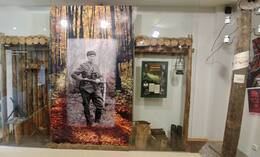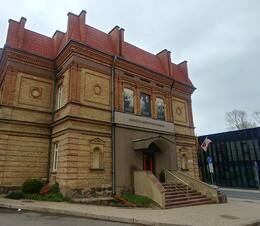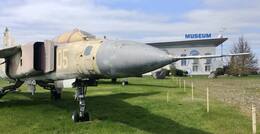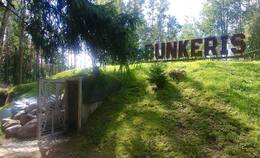Scenes of Soviet Lithuania
Day 4.
140 km
Panevėžys – Stanioniai – Likpetriai – Kaunas
Practical info
- Maršruts ir domāts kā padomdevējs - kā optimālāk apceļot reģionu vai valsti, vai divas valstis ar mērķi iepazīt to militāro mantojumu;
- Braucējam pašam ir jāizplāno – cik no ieteiktajiem objektiem un vietām viņš vienas dienas laikā var iepazīt;
- Pirms ceļojuma ir jānoskaidro apskates vietu (muzeju, kolekciju, fortifikācijas u.c. objektu) darba laiks;
- Vietās, kur ir iepriekšēja pieteikšanās (vietējie gidi, privātas kolekcijas, cits), ir jāpiesaka vizīte, norādot datumu un laiku. Ja ceļojums tiek atcelts, ir jāinformē pieteiktās vietas;
- Naktsmītnes ir jārezervē laicīgi. Vasaras sezonā, īpaši jūras piekrastē naktsmītnes var būt nepieejamas. Daļa no ēdināšanas uzņēmumiem ziemas sezonā var nestrādāt;
- Ceļojumam izvēlieties ne tikai vasaru, bet arī citus gadalaikus;
- Latvijas – Lietuvas – Igaunijas robežas pa autoceļiem var šķērsot brīvi bez ierobežojumiem un jebkurā diennakts laikā. Iebraucot no vienas valsts otrā ir jābūt līdzi ID kartei vai pasei;
- Apmeklējiet tūrisma informācijas centrus, kur var iegūt papildus informāciju, bukletus, kartes.
Sights
Exposition on the Resistance to Soviet Occupation and Sąjūdis at the Panevėžys Local Lore Museum
The exposition is located in an authentic place – the premises of the Panevėžys group of the Lithuanian reform movement “Sąjūdis”. The Sąjūdis of Panevėžys has been operating here since October 1988.
In 2004, an exposition on the resistance to the Soviet occupation and an exhibition dedicated to the “Sąjūdis” were opened in the building. The exposition reveals the extent and forms of popular resistance starting from 15 June 1940 to 11 March 1990, and introduces the most importantstages and events of the anti-Soviet movement, as well as Soviet repressions.
Expositions “Okupacijų gniaužtuose” (“In Squeeze of Occupations”) and “Raudonasis teroras” (“Red Terror”) at the Panevėžys Local Lore Museum
The expositions are located in downtown Panevėžys. The Soviets confiscated the house, built at the end of the 19th century for the rominent Moigiai family of Panevėžys. From 1940–1941 it housed the headquarters of the Soviet military unit, the interrogation department of the NKGB (People’s Commissariat for State Security) of Panevėžys District and the militia. From 1944 to 1953 it was the headquarters of the Panevėžys County NKGB-MOI-KGB. It is now the premises of the Panevėžys Local Lore Museum.
The Exposition “Okupacijų gniaužtuose” (“In the Squeeze of Occupations”) presents the Nazi and Soviet occupations. It introduces the themes of the Jewish and Roma genocide, deportations and the themes of partisan war. The part of the exhibition devoted to the years 1953–1990 tells the story of everyday life in Khrushchevka, the efforts of the Soviet government to create a Soviet society, the resistance of people to this violence, and the activities of the underground. You can hear recordings of radio broadcasts from abroad, secretly listened to by the people of the time, with radio interference caused by the Soviet authorities.
The exhibition “Raudonasis teroras” (“Red Terror”) is dedicated to the memory of the victims who were killed in the basement of this house, shot at the Panevėžys sugar factory, as well as the history of the crimes committed by the Soviet occupation regime. The hopes of free people and the destruction thereof under Soviet rule are allegorically depicted in time and space – the interior of the apartment of the merciful Sister Zinaida Kanis-Kanevičienė at the time of the independent Lithuania, who was tortured to death, and a replica of the interrogation room of the NKGB.
“Įstra” Aviation Museum
The museum is located 10 km from Panevėžys, on the left side of the Panevėžys-Pasvalys road (A10; section E67 of Via Baltica) (an informative road sign has been installed).
The museum was established in 2016, inspired by the aviator and aviation enthusiast Virmantas Puidokas, and is located on the grounds of the Įstra airfield. The airfield dates back to 1984 when planes took off from the airfield to spread fertilisers or other chemicals on the agricultural fields. The museum has an open-air and indoor exhibition. The open-air exhibition features Soviet-era Su-15, MiG-21 and MiG-23 fighters, Mi-2 and Mi-8 helicopters, as well as -29 military trainer aircraft built in Czechoslovakia (all aircraft were built in the 1960s and 1970s). Indoor exhibitions introduce the history of aviation in the world and in Lithuania, as well as military aviation equipment, devices and paraphernalia of World War I, World War II and the Cold War. A collection of military pilot equipment, rescue, communication, audio recording and other equipment from different countries is on display, as well as a collection of daggers from the parade uniforms of Air Force officers.
Soviet Army Military Base in the Green Forest / “Bunker” Park of Ideas
It is located near Paliūniškis, on the left side of the Paliūniškis- Vabalninkas road (KK191) (a signpost is installed), and it is accessible by a forest road.
Green Forest is the place where the participants of the 1863–1864 uprising, the murderers of the Jews of 1941, as well as the Soviet and Lithuanian partisans, have left their traces. It was also used by the Soviet Army. The forest was the site of a Soviet Air Force training ground, where bombing and shooting exercises took place. Locals have nicknamed the site “the bombarderia” because of the bomb pits that still persist. A Soviet military base was also stationed in the forest. Little is known about its purpose and history. It was probably built between 1961 and 1977 and is believed to have been a reserve base for military communications. The media, however, likes to refer to it as the Reserve Command Post of the Baltic Military District. A reinforced concrete panel fence, a bunker and ruins of ancillary buildings have been preserved.
In 2019, an amusement park – the “Bunker” Park of Ideas – was created here. The former bunker has Cold War-era military and civil defence equipment on display, and there is also a horror room in the bunker, with extensive use of military equipment and Soviet-era household items as decorations. The bunker is surrounded by a park of metal sculptures.







